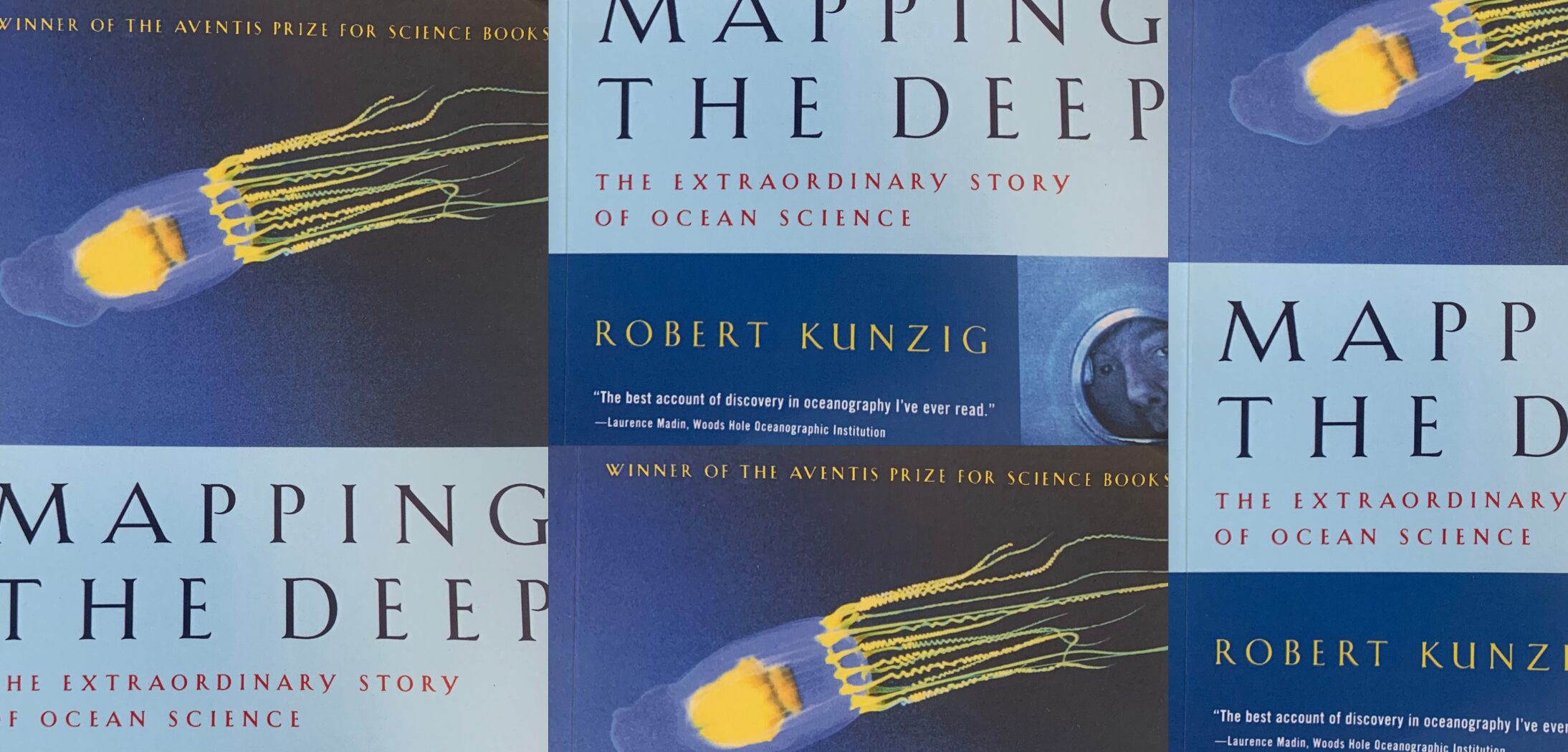
Mapping the Deep: a review
By Diane Esson, August 2025
A history of oceanography runs the risk of being – despite all the water obligatorily traversed – exceedingly dry. Robert Kunzig’s Mapping the Deep defies any such expectation. Like diving into the abyss for Davy Jones’s Locker and stumbling instead upon the Flor de la Mar, this history of oceanography is a treasure trove of striking analogies, unlikely characters and excellent banter. Thank you, Mr. Kunzig for making this a pleasure to read. And thank you, Hanu Singh, for the recommendation!
One of the things I greatly enjoyed was the cast of characters in oceanography’s century-and-a-half-long history. Characters who, by paths ranging from unlikely to whimsical to ridiculous, stumbled their way into the annals of deep-sea research. Characters including the inventor of croutons and drip coffeemakers who first realized cold water was entering the deep sea of the tropics by way of the poles. Or the son of an Iowa turkey farmer who, using a mixture of measurements and imagination, helped draw the first maps of the underwater world. Or the man who explained the physics of the Gulf Stream “on practically his first crack as an oceanographer” and did so at a highway rest stop enroute to Rhode Island. If ever there was a rule book for the qualities or experience required to become the next great thinker in deep-sea science, it should be well and truly thrown out by now.

I also got a giggle from the history of ocean mapping with echo sounding. At MARE-Madeira and through our TWILIGHTED project, we’re trying to come up with and use lower-cost alternatives to explore the deep sea. One instrument that continues to foil everyone – the navies, companies and institutions trying to reduce its cost and who appear to have reached a fairly hard limit – is sonar. Sonar capable of mapping the deep sea is still a very high-ticket item. But perhaps we’re being too fancy and should just go back to our echo sounding roots. Roots that started with a 1,100-pound church bell. Etsy suggests we could source one for around €400…
Speaking of deep-sea mapping and the price exclusion that means very few institutes are able to do it, it was also entertaining to learn how fooled we’ve been by it. After more than a century of very clever people and state-of-the-art equipment measuring and mapping the seafloor, enormous gaps continued (and continue) to persist. For example, until the 1990s, our deep-sea mapping efforts had managed to miss a range of underwater volcanoes that is longer and higher than the Alps. Imagine mapping Europe and overlooking the mountains that extend from France to Slovenia!

And while many a conference talk or article will paint a picture of our deep-seated deep-sea ignorance with the phrase “We know more about the surface of the moon than we do the bottom of our ocean,” it turns out it’s worse than that. We’ve mapped more of the surface of Venus, 180 million kilometers away, than we have our ocean. And we did that back in 1992! (You know your area of study is a bit tricky when interplanetary space exploration shakes out as the easier option.)
At least when we do find an interesting feature in the deep sea, we give it a better name than we give a lot of things in space (don’t take this personally, BD+17°3248). I believe ‘Tube-Worm Barbecue’ is a contender for the best hot spring christening, right up there with the enticing ‘Valley of the Shadow of Death’.
Of course, the real stars of any deep-sea research compendium are the deep-sea critters themselves. Starting with Them of the Legendary Barbecue: did you know tube worms in the deep sea can grow as tall as two and a half meters? These incredible, giant tube worms are survivors in the way dinosaurs weren’t and humans likely won’t be – they’ve been around 65 million years and counting, making it through asteroid collisions, ice ages and the last shutdown of the ocean’s thermohaline circulation. Worms for the win!
The deep is also home to ctenophores (read comb jellies) more ambitious than boa constrictors, swallowing prey up to three times their size. There are also animals called xenophyophores that look a bit like coral and grow to the size of your fist – but they’re a single cell! In another delightful story I learned that ‘snail’s pace’ in the deep has a very different meaning than on land – researchers apparently have a heck of a time trying to snatch these speed demons in pelagic waters.

Gastropod (L) by Karen Osborn, Smithsonian Institution
These are just a few personal highlights, but I still recommend reading Mapping the Deep for yourself! Just don’t try to swim through its facts in a single day – you might drown and never make it to the end. Which would be a great shame, for the last chapter hits like a mantis shrimp to the face.
With gratitude to Dr Hanumant Singh for generously gifting us this book after the Impossible Things Workshop!
References
Kunzig, R. (2000). Mapping the deep: The extraordinary story of ocean science. W. W. Norton & Company.
